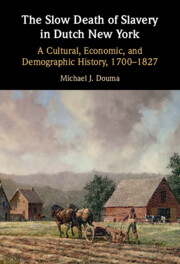 The Slow Death of Slavery in Dutch New York
The Slow Death of Slavery in Dutch New York Published online by Cambridge University Press: 20 December 2024
Chapter 4 is an extensive study of runaway slave advertisements that mention that a slave speaks Dutch. For this chapter, I have compiled a database of 487 enslaved persons, coded by year of flight, name, age, Dutch language ability, name of master, county, and original source. I demonstrate that runaway slave advertisements in New York City and environs plateaued in the period 1760–1800, but peaked later in the Hudson Valley, with exceptional growth in the 1790s and 1800s. The data provide evidence for the persistence of the Dutch language in New York and New Jersey and contribute to a picture of Dutch-speaking slaves presenting a sharp economic challenge to the institution of slavery. By the 1790s, Dutch-speaking slaves were running away at a rate of at least 1 per 500 per year. For Dutch slave owners, this meant a significant loss of capital and, moreover, a risk on their remaining slave capital. Runaway slaves tended to be prime working-age males, and the loss of the best field workers frustrated New York Dutch farmers. The pressure of runaway activity also lowered the value of retained slaves and made New York slavery more costly in general. Runaways put pressure on slaveholders to manumit their slaves, extracting the most labor possible from them before agreeing to let them go.
To save this book to your Kindle, first ensure [email protected] is added to your Approved Personal Document E-mail List under your Personal Document Settings on the Manage Your Content and Devices page of your Amazon account. Then enter the ‘name’ part of your Kindle email address below. Find out more about saving to your Kindle.
Note you can select to save to either the @free.kindle.com or @kindle.com variations. ‘@free.kindle.com’ emails are free but can only be saved to your device when it is connected to wi-fi. ‘@kindle.com’ emails can be delivered even when you are not connected to wi-fi, but note that service fees apply.
Find out more about the Kindle Personal Document Service.
To save content items to your account, please confirm that you agree to abide by our usage policies. If this is the first time you use this feature, you will be asked to authorise Cambridge Core to connect with your account. Find out more about saving content to Dropbox.
To save content items to your account, please confirm that you agree to abide by our usage policies. If this is the first time you use this feature, you will be asked to authorise Cambridge Core to connect with your account. Find out more about saving content to Google Drive.